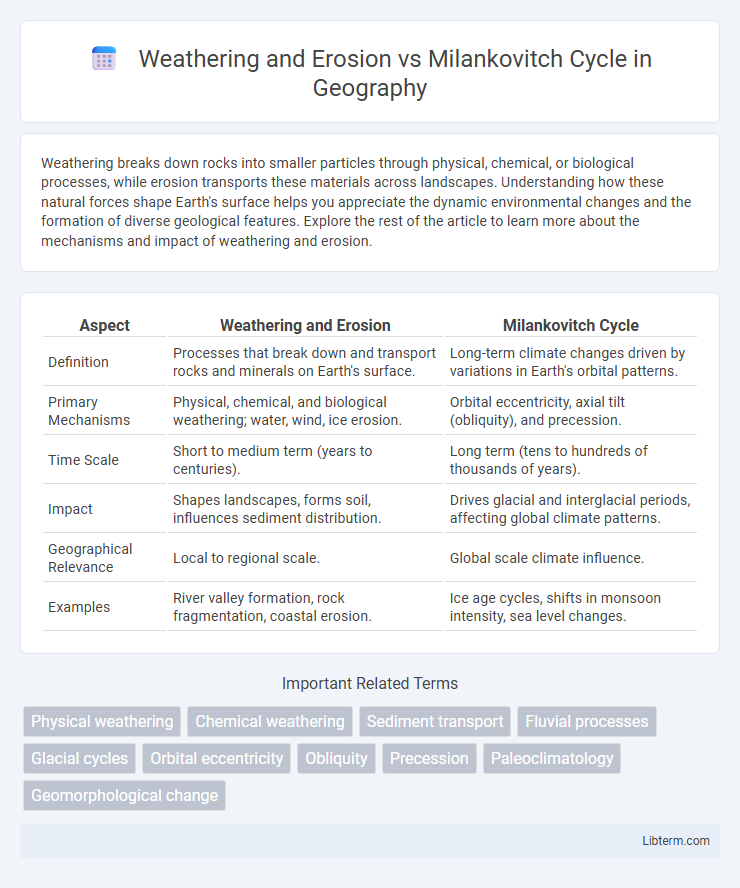Weathering breaks down rocks into smaller particles through physical, chemical, or biological processes, while erosion transports these materials across landscapes. Understanding how these natural forces shape Earth's surface helps you appreciate the dynamic environmental changes and the formation of diverse geological features. Explore the rest of the article to learn more about the mechanisms and impact of weathering and erosion.
Table of Comparison
| Aspect | Weathering and Erosion | Milankovitch Cycle |
|---|---|---|
| Definition | Processes that break down and transport rocks and minerals on Earth's surface. | Long-term climate changes driven by variations in Earth's orbital patterns. |
| Primary Mechanisms | Physical, chemical, and biological weathering; water, wind, ice erosion. | Orbital eccentricity, axial tilt (obliquity), and precession. |
| Time Scale | Short to medium term (years to centuries). | Long term (tens to hundreds of thousands of years). |
| Impact | Shapes landscapes, forms soil, influences sediment distribution. | Drives glacial and interglacial periods, affecting global climate patterns. |
| Geographical Relevance | Local to regional scale. | Global scale climate influence. |
| Examples | River valley formation, rock fragmentation, coastal erosion. | Ice age cycles, shifts in monsoon intensity, sea level changes. |
Introduction to Weathering, Erosion, and the Milankovitch Cycle
Weathering and erosion are fundamental geological processes that break down rocks and transport sediments, shaping Earth's surface over time. The Milankovitch Cycle refers to long-term variations in Earth's orbit and axial tilt, influencing global climate patterns and glacial cycles. Understanding these processes is essential for interpreting landscape evolution and predicting climate-driven environmental changes.
Defining Weathering: Types and Processes
Weathering involves the physical breakdown and chemical alteration of rocks at or near Earth's surface through processes like mechanical weathering, which includes freeze-thaw cycles and abrasion, and chemical weathering, such as hydrolysis and oxidation. Erosion transports the weathered material through agents like water, wind, and ice, reshaping landscapes over time. In contrast, the Milankovitch Cycle describes long-term variations in Earth's orbital parameters that influence climate patterns and glacial periods, without directly causing weathering or erosion processes.
The Nature of Erosion: Mechanisms and Effects
Weathering and erosion involve the physical breakdown and chemical alteration of rocks and soil, driven by agents such as wind, water, ice, and biological activity, which reshape landscapes by transporting sediment. These processes influence sedimentation rates, soil fertility, and the formation of landforms like valleys, cliffs, and deltas. In contrast, the Milankovitch Cycle refers to long-term variations in Earth's orbit and axial tilt, affecting global climate patterns that indirectly impact erosion intensity and distribution by altering precipitation and temperature regimes.
Overview of the Milankovitch Cycle
The Milankovitch Cycle describes long-term variations in Earth's orbital parameters, including eccentricity, axial tilt, and precession, which influence climatic patterns over tens of thousands to hundreds of thousands of years. These cyclical changes affect the distribution and intensity of solar radiation reaching Earth's surface, driving glacial and interglacial periods. Unlike weathering and erosion, which alter landscapes through surface processes, the Milankovitch Cycle operates on a global climatic scale by modulating Earth's energy balance.
Weathering and Erosion: Driving Forces of Surface Change
Weathering and erosion are fundamental processes shaping Earth's surface by breaking down rocks and transporting sediments, which significantly modify landscapes over time. These mechanisms regulate the carbon cycle by facilitating the chemical weathering of silicate minerals, thereby influencing atmospheric CO2 levels and global climate. Unlike the Milankovitch cycle, which drives long-term climatic variations through orbital changes, weathering and erosion directly drive surface change by altering terrain morphology on both local and regional scales.
Milankovitch Cycle: Astronomical Influences on Earth’s Climate
The Milankovitch Cycle describes the long-term variations in Earth's orbit and axial tilt that influence solar radiation distribution, driving significant climate shifts such as ice ages and interglacial periods. These astronomical factors operate over tens of thousands to hundreds of thousands of years, affecting global temperatures and precipitation patterns independent of surface processes like weathering and erosion. While weathering and erosion reshape the Earth's surface, the Milankovitch Cycle fundamentally controls the timing and intensity of climatic changes by altering Earth's position relative to the sun.
Comparing Time Scales: Weathering/Erosion vs. Milankovitch Changes
Weathering and erosion processes typically occur over thousands to millions of years, gradually shaping landscapes by breaking down rocks and transporting sediments. In contrast, Milankovitch cycles, driven by variations in Earth's orbit, tilt, and precession, operate on timescales of approximately 20,000 to 100,000 years, influencing long-term climate patterns such as ice ages. The faster, continuous action of weathering and erosion interacts with the slower but periodic Milankovitch-induced climate changes to affect Earth's surface and atmospheric dynamics over geologic time.
Interconnection: How Earth Processes Respond to Astronomical Cycles
Weathering and erosion rates are influenced by Milankovitch cycles, which alter Earth's climate patterns through changes in solar radiation, affecting temperature and precipitation. These astronomical cycles drive glacial and interglacial periods, modulating the intensity of weathering processes and sediment transport. Consequently, Earth's surface processes respond dynamically to orbital variations, linking geological changes to cyclical astronomical forces.
Impacts on Climate and Landscapes
Weathering and erosion directly influence climate by regulating atmospheric carbon dioxide levels through the breakdown of rocks and the transport of sediments, which can reduce greenhouse gases and promote global cooling. The Milankovitch Cycle drives long-term climate changes by altering Earth's orbital parameters, causing periodic shifts in solar radiation that trigger glacial and interglacial cycles. Together, these processes reshape landscapes over geological timescales, with Milankovitch-induced climate fluctuations affecting weathering intensity and erosion rates, thus sculpting Earth's surface features.
Conclusion: Integrating Surface and Astronomical Earth Processes
Weathering and erosion continuously reshape Earth's surface by breaking down rocks and redistributing sediments, while the Milankovitch cycle regulates long-term climatic variations through orbital changes affecting solar radiation distribution. Integrating these geological and astronomical processes highlights how surface dynamics interact with climate drivers, influencing Earth's environmental evolution over multiple timescales. Understanding this interplay enhances predictions of landscape transformation and climate feedback mechanisms essential for comprehensive Earth system science.
Weathering and Erosion Infographic

 libterm.com
libterm.com